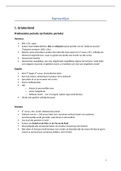College aantekeningen
Unit 7 - Land Law - Engage/Prep Taks - Solved
- Vak
- Instelling
I scored a 90 on my SBAQs so I had a pretty strong grasp of the concepts on Land Law. About this doc: Key words in the answers: Implied easements. Union Lighterage v London Graving Dock Company. Wong v Beaumont Property Trust Ltd. Wheeldon v Burrows. Doctrine of Lost modern Grant. Simmons v D...
[Meer zien]












